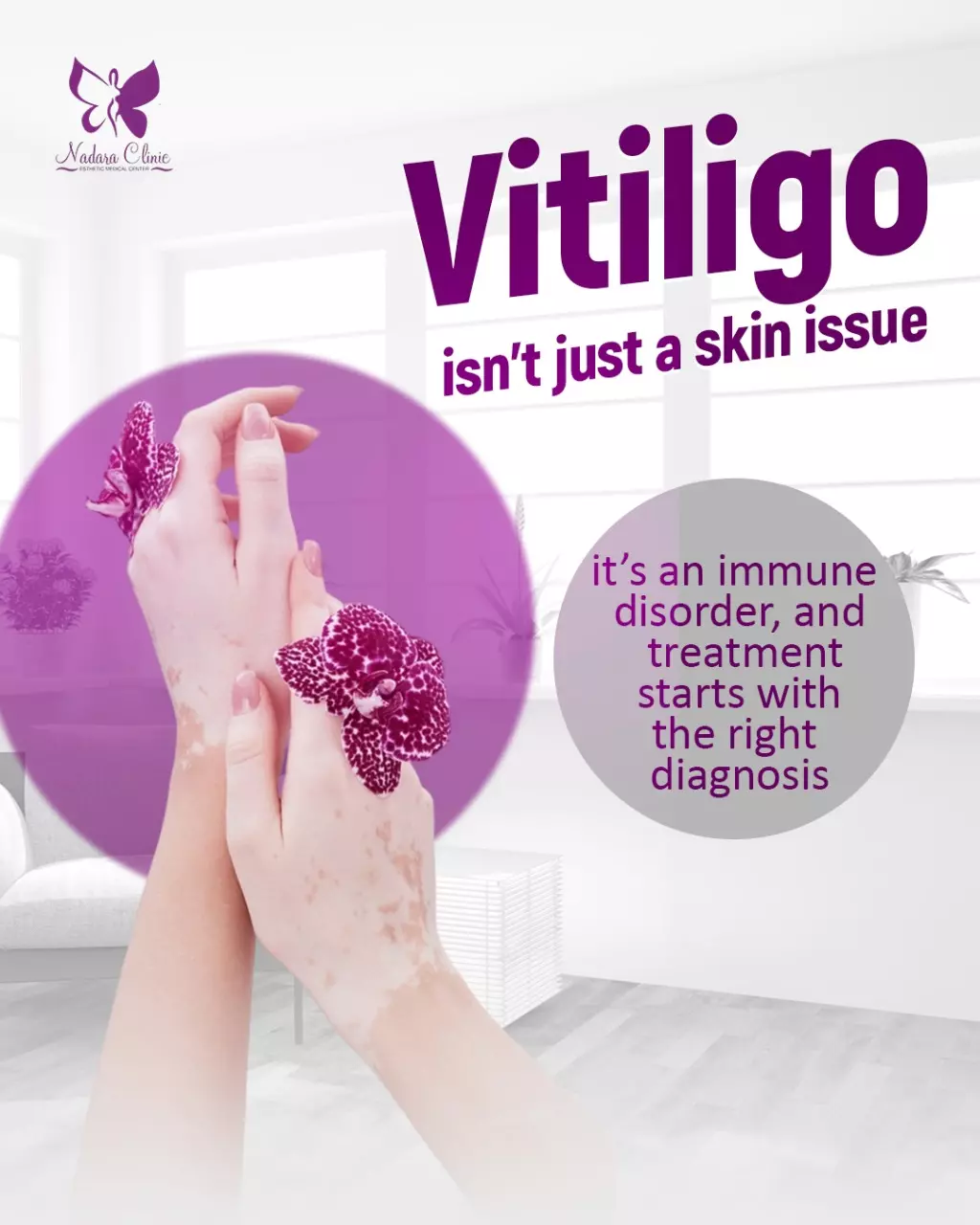Vitiligo is an acquired disease and its only symptom is the appearance of light spots on the skin. The prevalence of the disease in the total world population is 1%, regardless of source and gender. The disease begins before more than 50% of those affected are 20 years old.
This disease has been known in Indian and Buddhist civilizations since 1000 BC. Carriers of the disease have been preserved in all civilizations. They are often exiled outside the population. The cause of the damage is the production of melanocytes. Melanin Melanin is a colored substance in the skin that lacks melanin due to a lack of melanocytes.
The accepted theory in explaining vitiligo is that the cause of the disease is related to an autoimmune process. This is because the disease is associated with many other diseases with autoimmune backgrounds.
Vitiligo in dark-skinned people, because the color contrast is more obvious, vitiligo generally begins on exposed parts of the body after exposure to the sun or trauma in the spring, and the wounds vary in size, small and few. to a large area.
Vitiligo does not accompanies any other diseases, but is more commonly caused by mood disorders. There is no evidence that vitiligo is caused by psychological factors, and there is no basis for assuming that vitiligo is associated with malignant diseases, that is, the underlying precancerous process.
Vitiligo Symptoms
Symptoms of vitiligo may appear in any part of the body, but the most common ones appear in the eye sockets and knees in the initial stage of the disease, and may also appear in other parts of the contact, and the scope of spread is usually the same. This can be clarified through the following points:
Light-colored halos appear around the moles on the body, and when these halos increase, clear symptoms of vitiligo appear.
The white spots on the face and the back of the hands are more noticeable, and with age the infection settles for a while and develops slowly over time, but sometimes it is still a local infection or is found in multiple areas.
Intermittent loss of skin color, usually on the hands, face, and areas around the body openings and genitals.
Premature bleaching or graying of scalp hair, eyelashes, eyebrows, or beards.
The tissues inside the mouth and nose lose their color.
The light spots are often milky white.
Causes and risk factors for vitiligo
1. The cause of Vitiligo
Although the cause of vitiligo is not fully understood, there are many possible causes, which include:
- Autoimmune diseases: The affected person's immune system may produce antibodies that destroy melanocytes.
- Genetic factors: Some of the factors that may increase the chance of developing vitiligo can be hereditary, because about 30% of cases of vitiligo are hereditary.
- Nerve agent: a substance toxic to melanocytes that can be released into the nerve endings of the skin.
- Self-destruction: Defects in melanocytes lead to self-destruction.
Vitiligo may also be caused by certain events, such as physical or emotional stress; Since none of these explanations seem to fully explain this situation, the combination of these factors may be the cause of the vitiligo.
2. Vitiligo risk factors
The main risk factors include the following:
- A family member has the disease.
- Having a family history of other autoimmune diseases, for example if one of your parents has pernicious anemia, which is a condition of autoimmune diseases This may increase your chance of developing vitiligo.
- Having another autoimmune condition.
- having skin cancer, or Lymphoma The non-Hodgkin's.
- The presence of certain changes in genes known to be associated with vitiligo.
Complications of vitiligo
- Vitiligo does not develop into other diseases, but people with this disease are more likely to develop:
- Painful sunburn.
- hearing loss.
- Vision changes and tears.
- Social or psychological distress.
- sunstroke.
- eye problems
- People with vitiligo are more likely to have other autoimmune conditions, such as thyroid problems, Addison's disease, thyroiditis, type 1 diabetes, or pernicious anemia. Most people with vitiligo do not have these conditions. But it can be tested to rule it out.
Vitiligo Diagnosis
Among the most important diagnostic methods are:
1. Clinical examination
Vitiligo is usually diagnosed clinically and does not require any tests to diagnose it, because white spots are easier to see under a wooden lamp examination, and black-light dermatoscopy characteristically shows white light.
2. Skin biopsy
Sometimes a skin biopsy may be recommended, especially in the early stage when lymphatic infiltration is observed or in inflammatory vitiligo, there are no melanocytes and epidermal pigment in the white plaque.
3. Do blood tests
Blood tests may be arranged to evaluate other underlying autoimmune diseases or polyglandular syndromes, such as thyroid function and vitamin B12 levels.
4. Diagnostic imaging procedure
Clinical images can be used to record the prevalence of vitiligo under observation. Continuous digital photos can be arranged at a later time. The prevalence of leukoplakia can be measured by the surface area of the body that has been decolorized.
Vitiligo treatment
1. Medicine
No medication can stop the development of vitiligo, but some medications can help restore some skin tone when used alone or with light therapy or laser therapy. Among the most important drugs are the following:
Medicines to control inflammation
Applying a corticosteroid cream to the affected skin may restore color, as this is most effective when the vitiligo is still in its early stages.
This type of cream is effective and easy to use, but you may not notice a change in skin color for several months. Possible side effects include thinning of the skin or the appearance of streaks on the skin.
Medicines that affect the immune system
Calcineurin inhibitor ointments such as tacrolimus or pimecrolimus may be effective for people with small areas of pigmentation, especially on the face and neck.
2. Medical procedures
Noteworthy medical procedures include:
- light therapy Narrowband UVB light therapy can prevent or slow progression of active vitiligo and has been shown to be more effective when used in combination with corticosteroids or calcineurin inhibitors.
- Combined psoralen and light therapy : This treatment combines a plant-derived substance called psoralen with photochemotherapy to restore the color of the spots. After taking psoralen orally or applying it to the affected skin, you will be exposed to ultraviolet light. Although this method is effective, it is difficult to control and has been replaced by narrowband ultraviolet light therapy in many practices.
- pigmentation : If vitiligo is common and other treatments are ineffective, you can opt for this treatment. Apply a depigmentation agent to the unaffected skin area. This will gradually lighten the skin and blend in with the discolored area. The treatment is done once or twice a day for nine months or longer.
3. Surgery
Notable surgeries include:
- Skin grafting During this process, your doctor will transfer a small portion of your healthy, pigmented skin to the area that has lost pigment. If you have small white spots, this procedure is sometimes used.
4. Laser therapy (excimer laser)
It is the latest method or method of treatment and restoration of the formation of the melanin layer of the skin by directing a laser flash to the areas affected by vitiligo. This method is characterized by rapid results and effectiveness.
vitiligo prevention
Since no one knows exactly what causes Vitiligo, no one can tell you how to prevent it, but it is important to do safe exposure to the sun and take good skin care.
Common Types of Vitiligo
The most common types of vitiligo include:
- General: This is the most common type, when the spot appears on different parts of the body.
- Partial: confined to one side or area of the body, such as the hands or face.
- Mucous membrane: It affects the mucous membranes in the oral cavity or the genitals.
- Focal: This is a rare type in which the macular is located in a small area and does not spread in a specific pattern for one to two years.
- Hairy: This means a white or colorless center, then an area of lighter pigmentation, then an area of skin with a normal color.






